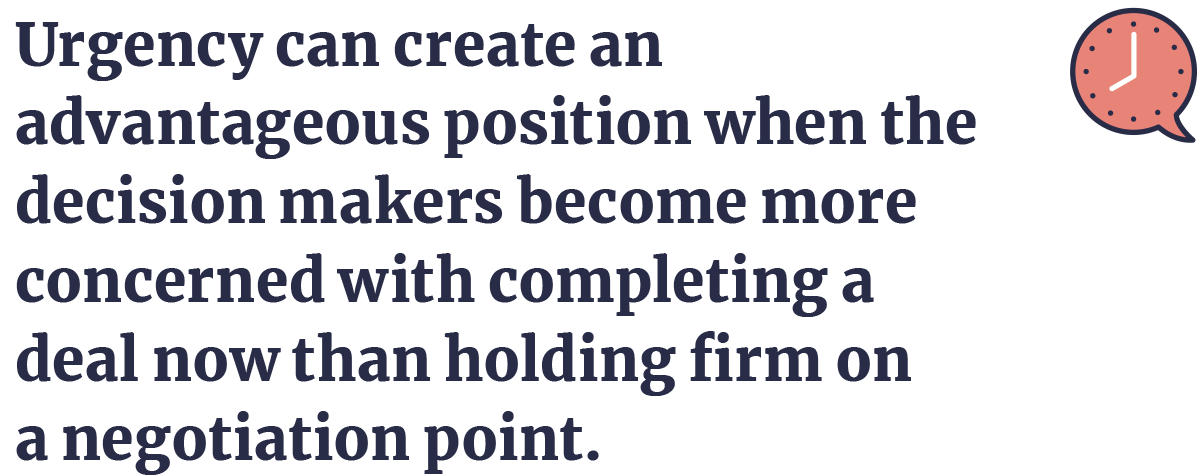Many of us have haggled over the price of a car, negotiated a pay raise, or bartered with a street vendor while on vacation. Some of us have hammered out multimillion-dollar software deals while others have sat at the table in a high-level negotiation over a parts or service contract. Negotiating is an unavoidable and everyday part of our lives, but it’s not always something people are comfortable with or effective at doing.
In fact, what image comes to mind when you think about negotiating? For those excited by the back-and-forth of the negotiating process, it might be the iconic scene in The Godfather where Brando speaks the famous line, “I’ll make him an offer he can’t refuse.” For those who are uncomfortable with negotiating, or who are always skeptically wondering how the other party is trying to swindle them, it may be an image of a street vendor selling fake purses and Rolex watches that fall apart the moment you get those products home.
In business, negotiation theory is viewed as a battle with winners and losers. Leaders are encouraged to read The Art of War by Sun Tzu — or, more recently, to seek a “win-win” scenario by adopting the Nash Equilibrium and optimizing a strategy that considers their opponents’ decisions.
Negotiating is both highly analytical and highly emotional — part science and part art. And while there are many well-established rules that can help you approach any supplier negotiation with confidence, some guidelines (such as whoever speaks first loses) can be counterproductive if applied incorrectly or in the wrong situation.
In this article, we’ll walk you through a four-step negotiating process designed to maximize your position in any negotiation, achieve your desired result, and understand what levers produce outcomes that align with the core interests of each party at the negotiation table.

1.
Develop a playbook around your goals
Before entering any negotiation, it’s important to understand your priority requirements and align your goals with those of your teammates. What are your core motivating factors? What do you want to achieve? Price is certainly a major concern in almost any negotiation with a supplier, but obtaining the lowest price isn’t always the primary driver. Early in a program, or when introducing a new product to market, price may take a back seat to knowing with confidence that parts will be delivered on time and at quality. If price is your main negotiation lever, however, what are you willing to give up to secure a lower rate?
Consider this case study. An automotive OEM wanted to lower its part costs but was hesitant to launch a major supplier initiative because of past failures. A team of consultants at Jabian quickly discovered that the OEM’s contracts required an annual cost reduction from suppliers regardless of market conditions. As a result, suppliers were incented to front-load their pricing for new parts because they were expected to lower the price at the end of the year. There was no room in the contract structure to align incentives for suppliers who were more flexible with the price of their parts. Upon this realization, the OEM waived the annual reduction requirement and moved to an immediate reduced pricing structure that could exceed the annual reduction.
For corporate negotiations, it’s also critical to remember that you’re rarely a lone wolf. It’s more likely that you are working with teammates across functions (especially for a technology solution) with goals other than price — i.e., end-users (functionality), legal (contracting/risk management), finance (supplier financial viability), etc. Your ability to empathize with these teammates, as well as understand their requirements, will help as you manage the process to secure the desired end result for all parties involved.
Before you sit down at the negotiating table, huddle up with your teammates and define your “negotiation envelope” — the range of your acceptable outcomes as bounded by your Most Desirable Outcome (MDO) and your Least Acceptable Agreement (LAA). Everybody should know if and when you can accept an agreement with the supplier, and they should all be on the same page.
And finally, don’t forget to define your Best Alternative to a Negotiated Action (BATNA) in case you and the supplier are unable to reach an acceptable agreement. To define your BATNA, make sure you walk your teammates through the following questions:
- List all alternatives to the current negotiation — what could you do if negotiations fall through?
- Evaluate each alternative — how much is each alternative worth to you?
- Select the alternative that would provide the highest value to you (this is your best alternative to a negotiated agreement).
- After determining your BATNA, calculate the lowest-valued deal that you’re willing to accept.

2.
Scout the opposition
Once you’ve developed your core motivating factors, negotiation envelope, and BATNA, you’re ready to focus on the next step of the process: figuring out what the other party wants. To be successful in any negotiation, you need to understand the supplier’s priority requirements and core motivating factors — essentially, what they need — as well as you know your own. To share that information, however, they must feel safe enough to talk about what they really want. Negotiation begins with listening to the other party, validating their concerns and emotions, building trust, and creating a safety net that allows for real conversations.
One simple tactic used to build trust with another party, according to Chris Voss in Never Split the Difference, is “mirroring” — or repeating the last three words (or the critical one to three words) of what someone has just said but phrased as a question. Mirroring works well — especially with those you don’t know well — because people naturally fear what is different and find comfort in similarity. Mirroring is an effective tactic to keep the other person talking and buy time, and it often leads a person to inadvertently reveal their strategy.
Again, it is easy to assume that price — in this case, securing the highest possible price for their product — is the supplier’s motivating factor. However, that’s often not the case. For example, a salesperson may need a sale to hit a quota, and earning the sale before the quota deadline is more important than the final price.
Even in corporate negotiations, price is not always the key motivating factor. In our earlier example, the supplier was willing to sacrifice revenue rather than expend the labor to justify how they were reducing the price each year. In other cases, the supplier may be interested in securing higher volume levels or earning the ability to bid on future business as a preferred supplier.
But how do you know if a supplier’s core motivation is something other than price? Depending upon the strength of your relationship, you can simply ask up front. In the absence of trust, calibrated questions to probe potential beneficial value can help you collect this information using empathy. For example: Are they interested in partnering to innovate on any new technologies or products? Are they looking to grow and are they making investments into larger facilities and tooling/resources? Do they see value in promoting you as a customer?
Answers to these questions can help you understand where their priorities lie — and whether they see you as a growth partner with whom to invest in a long-term relationship or as more of a transactional account. Once you know the supplier’s goals, you can anticipate where you have leverage and where their sticking points might surface –both will help drive your negotiation strategy.

3.
Know your leverage by analyzing market conditions
While understanding what drives you, your teammates, and the person sitting across the table is imperative to negotiating a successful deal, you can’t implement your strategy without also recognizing the amount of leverage and flexibility that you can realistically apply.
To understand your leverage, you must investigate the external market conditions influencing your negotiation. Use market assessment reports and word-of-mouth references to understand the market position, strengths, weaknesses, and standard pricing. Discover the scarcity of the products or solutions that they can provide.
The specificity of your purchasing requirements might lead to a limited number of suppliers with either the expertise, solution functionality, materials, or delivery capabilities to meet your requirements. Simple supply-and-demand theory tells you that with limited supply you have limited leverage to drive supplier competition. When your requirements are easily met from a variety of vendors (as with commodities), then vendors will need to compete for your business. For commodities, pricing is likely set consistently across the market, and you now have leverage to drive value from things like payment terms, service level agreements, or flexibility from the supplier to innovate additional value during the partnership.

4.
Use these negotiating tactics to gain an advantage
Information is a critical component to any successful negotiation, and your objective is to uncover as much of it as possible. But data alone doesn’t win a negotiation. Emotional intelligence and empathy are both tools at your disposal to help you avoid focusing purely on the logical outcomes. Psychological tactics can be the difference between a prepared negotiator and a highly skilled one. Simply, expert negotiators own the process with tactics that blend urgency, bidding, and empathy to their advantage.
Do not hurry.Try to reduce urgency. Set a negotiating schedule that builds in ample time for the sharing of initial positions, bargaining over key areas, and fine-tuning the details of the agreement. Negotiations can often take longer than expected and if the key decision makers have made internal commitments to their leadership, then a tight timeline can lead to rushed decisions with long-term negative consequences.
In some instances, however, it may be beneficial to use the clock to your advantage. For example: Some negotiators fly in key decision makers for a final session but then wait until a few hours before their return flights before starting serious deal making. Urgency can create an advantageous position when the decision makers become more concerned with completing a deal now than holding firm on a negotiation point. Urgency can be generated by a desire to not miss their flight home or waste the sunk cost of a business trip. Whatever strategy you take, though, don’t allow the clock to be used as a lever against you in a negotiation.

Price bidding to get to a “fair” agreement. Understand that whoever makes the first offer is setting an anchor for the deal. You should feel comfortable speaking first if you can confidently establish a price range with credibility that moves the other side off their defensive position — for example, “Typically we’ve seen suppliers offering this item between $25 and $40 per SKU.” Also be prepared to set an extreme anchor or receive an extreme anchor without reacting emotionally. An extreme anchor is a price point that is offered knowing that the other side will not accept, but it can recalibrate what someone believes is a fair price for the goods being exchanged.
Ranges and anchors are just the starting point for price negotiation. You can try to apply standard guidelines to initiate offers and counteroffers. For example:
- Set your first offer at 65 percent of your target price
- Calculate three price raises of decreasing increments (e.g., to 80, 90, and 100 percent)
- Use different and empathetic ways of saying “no” to get the other side to counter
After a few rounds of back and forth, be ready to use a specific number that sounds less rounded. For example, instead of using a number that ends in zero, throw out a number like $23,248 as your final offer. Highly specific numbers create the illusion that you have put thoughtful calculation into the exact figure of the way you perceive the value of what you are buying or what you can afford. Round numbers often feel like there could be additional wiggle room for more negotiation.
Shift the negotiation from a “competition” into a team exercise to gain empathy. Sometimes the key to achieving an outcome that both parties are comfortable with is to have them develop those outcomes together. When negotiations bog down or stall, ask questions like: How can we solve the problem? What are we trying to accomplish here? Rather than continuing to exchange offers and counteroffers, try to brainstorm potential solutions as a group exercise. Equally important, try to focus them on solving for your needs with questions like: How am I supposed to do that? What are we trying to accomplish here? How can we solve this problem? By creating a sense of teamwork and empathy, it’s possible to enlist your negotiating partner to help solve for your core motivating factors.
